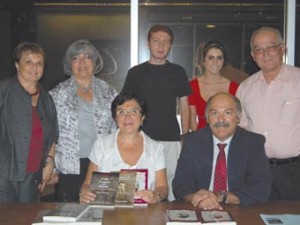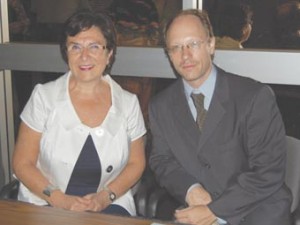Ruzan Orkusyan
Staff Writer

Photo: Erica Magarian
An extraordinarily intelligent and compassionate woman, Dr. Rita Kuyumjian, distinguished for her volunteer work within the Armenian community, most notably after the 1988 earthquake, presented a fascinating lecture on “Trilogy-April 24, 1915: Before and After-The Lives of the Survivors” on September 20th in the University Business Center. The Armenian Studies Program and Tekeyan Cultural Association of Fresno sponsored Dr. Kuyumjian’s vivid lecture. The passion with which she spoke resonated within the hall and conveyed the profound magnitude and sorrow of the Armenian Genocide while highlighting the importance of the intellectuals who suffered through it.
Dr. Kuyumjian, an Assistant Professor of Psychiatry at McGill University, Canada, and author of an insightful psychobiography Archeology of Madness on the composer Komitas Vartabed, introduced her Trilogy of books, discussing the immediate aftermath of the Genocide. The Trilogy is a treasure chest of our forgotten past, enhancing our view and understanding of the ghastly events that took place on and after April 24, 1915.
Dr. Kuyumjian’s presentation was focused on Trilogy April 24, 1915, a three-volume work dedicated to the 95th anniversary of the Armenian Genocide. It is a stunning continuation of Archeology of Madness, probing further the clouded details of April 24.
The first volume, Exile, Trauma, and Death; On the Road to Chankiri with Komitas Vartabed by Aram Andonian contains 25 articles, translated by Dr. Kuyumjian, written between 1946-1947. In memory and honor of Komitas Vartabed, “symbol of the Armenian Genocide,” Andonian, an intellectual rounded up in April 1915 along with Komitas, was commissioned to write these articles about the conditions leading up to Komitas’ mental breakdown. These were originally published in an independent periodical in Paris, however, when the newspaper ceased to exist, the articles slowly retreated into oblivion. These crucial pieces of history chronicling the first three days of the Genocide were forgotten until now.

Dr. Kuyumjian’s translations illuminate the lives of lesser-known Armenian intellectuals and their important literary contributions, essential for an enhanced understanding of the Genocide. By adding innovations of her own, such as biographies for each entry and an epilogue, she endeavored to make the reading more accessible. This powerfully vibrant and meticulous work is a crown jewel of Armenian history brought to us by Dr. Kuyumjian, an important work expressing the magnitude of loss, the suffering, and the tragic events of the first days of the Genocide.
Volume II consists of two parts; the first, is a biography of the author Teotig. Perhaps his most important contribution was the 19 volumes of Everyone’s Almanac, small encyclopedias recording the day-to-day lives of the Armenian community in Constantinople. The second part is a translation of Teotig’s work Monument to April 11 [where April 11 is equivalent to April 24]. It lists the names of 763 Armenian social, religious, and community leaders, as well as their biographies and circumstances of death in 1915.
Dr. Kuyumjian had, through her research, found out about her husband’s grandfather whose fate had remained a mystery until then. Knowing this makes it much more believable that others across the world will be able to accomplish the same.
Volume III, titled The Survivor, is Aram Andonian’s biography. Andonian was a historian, journalist, and a known and feared satirist, always ready to make note of what was said or done, truly earning the name “father of Genocide studies.” His ability to observe in a detached manner made him a reliable source, especially as he documented the events of the Genocide.
The lecture ended with a potent reading of chapter ten from The Survivor, that brought tears not only to my eyes, but also touched the hearts of all listening. Captivating and intriguing, the lecture delved into the dark past of the Genocide, shining a novel glow on the delicate topic through a fervent presentation that made me want to learn more about the past of my rich culture.
Dr. Kuyumjian’s memorable lecture was full of the same passion overflowing in her works, inviting the audience, Armenians and Americans, young and old, to further explore the nuances and fine details of the Armenian Genocide.
 Hye Sharzhoom Armenian Action
Hye Sharzhoom Armenian Action